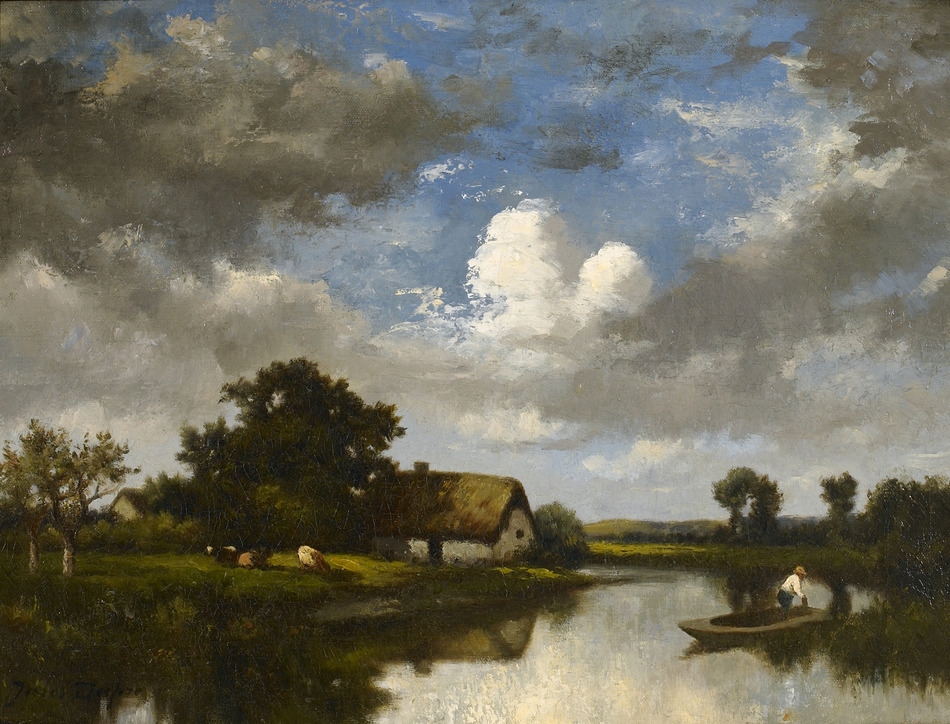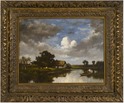Landscape with figure in a boat
Signed lower left: Jules Dupré
Provenance:
William Thompson Walters, Baltimore
Gift from the above to John H. Schaefer and J. William Schaefer
Flora Lambert, née Flora Sophia Schaefer
John Lambert
Thence by descent to private collection, USA
The current work once belonged to William Thompson Walters of Baltimore, MD, whose collection eventually established the Walters Art Museum. Walters began to collect art during the late 1850s, taking an interest in contemporary European painters. At the outbreak of the American Civil War in 1861, Walters took his family to Paris for the duration of the War. With George A. Lucas, a Baltimorean who four years earlier had moved to France, as their guide, William and Ellen Walters toured the major museums and visited artists' studios. Although his income was limited at the time, Walters patronized contemporary French artists much as he had in Baltimore and New York, commissioning works from Gérôme, Honoré Daumier, and Antoine-Louis Barye, among others. Upon his return home after the war he continued to expand his art collection, focusing on two fields, contemporary European painting and Asian art. Buying at auctions in New York, and relying on Lucas in Paris to transact purchases abroad, he specialized in French landscape and historical genre paintings.
It seems that Mr. Walter gave the current work, Landscape with figure in a boat to John H. Schaefer and J. William Schaefer in partial payment, along with a bronze by Barye, for photographic work. The father and son team were prominent portrait and landscape photographers in Baltimore in the late 19th century. They operated the Gallery of Artistic Photography in Baltimore, and the younger Schaeffer made something of a mark by making panoramic views of Baltimore, especially following the great Baltimore fire in the early 1900's.
Jules Dupré was born in Nantes on April 15, 1811. His father was an artist who decorated porcelain and held the position of director at several porcelain manufactories. In 1822, Dupré worked for his father as an apprentice porcelain decorator. His early training as an artist was in the industrial arts, as it was for many of his contemporaries. While working with his father, he also executed drawings and paintings from nature.
Dupré was influenced by his close association with DeMarne and Bertin and in 1829 he went to Paris where he further developed as an artist through his friendship with Cabat. Associations with the artists Decamps, Jeanron, and Huet were also formed at this time.
Traveling to Great Britain in 1831, Dupré made a study of the paintings by English landscape artists. He also sketched and returned to France with a portfolio of imagery. His travels did not stop there though and the French provinces also provided great inspiration for the young artist. Early success came when he began exhibiting in the 1830?s and especially in 1833 when four of his works were accepted into the Salon. Official recognition came in 1835 when he exhibited four landscapes at the Salon and received a third-class medal. He also included works in regional exhibitions, which were becoming increasingly important as they supported and promoted local painters and upcoming Parisian artists.
It was at this time that Dupré became a key figure in the Barbizon group. He developed close ties with other Barbizon painters and began to promote relations with independent art dealers. When Dupré showed seven paintings at the 1839 Salon, it was to be his last exhibition, until 1852, and a turning point in his career. This was due to the insensitivity of the jury and the lack of understanding of many of his colleagues. Together with Cabat, Huet, Isabey, Corot, and Rousseau, Dupré organized a petition to change the jury system.
After the 1848 Revolution Dupré became a member the commission created to reorganize the Salon. In 1849, he received the Legion d?honneur and continued to achieve financial success. At this time he reentered the Salon as an exhibitor. In 1867 he exhibited at the Exposition Centennale.
Jules Dupré had fully developed as an artist by the 1870?s and was considered one of the leading landscapists of his time. He continued to paint until his death in 1889.
Selected Museum Collections:
Baltimore, Walters Art Museum; Boston, Museum of Fine Arts, McMullen Museum of Art; Chicago, DePaul University Museum; Cincinnati, Art Museum; Cleveland, Museum of Art; London, National Gallery, Wallace Collection; Minneapolis, Institute of Art; New York, Frick Collection, Metropolitan Museum of Art; Paris, Louvre, Mobilier National, Musée d?Orsay; Pasadena, CA, Norton Simon Museum; Rennes, Musée des Beaux-Arts; Saint Petersburg, Hermitage; San Francisco, Fine Arts Museums; Toronto, Art Gallery of Ontario; Vic-sur-Seille, Musée Départemental Georges de la Tour; Washington D.C., National Gallery of Art; West Palm Beach, FL, Norton Museum of Art;
Request more information
News on the artist
-
The Clark has an exhibition of British & French landscapes, including #Barbizon painters #Rousseau, #Dupré, and #Troyon. http://t.co/JEEym3mJuly 27, 2011 @ 2:40 PM UTC
-
Now in Glasgow: #Millet #Barbizon Pastel of "The Angelus" Allocated to Kelvingrove Art Gallery and Museum: http://t.co/soF2LMA via @AddThisAugust 1, 2011 @ 3:35 PM UTC
-
See the great-grandfather of French landscape painting @AshmoleanMuseum: http://t.co/3KFFPXqu #Barbizon #exhibitionsOctober 6, 2011 @ 3:00 PM UTC
-
National Gallery of Art to reopen 19th-century French galleries in January: http://t.co/2HcCfSuF #Academic #PostImpressionist #BarbizonOctober 20, 2011 @ 9:17 PM UTC
-
Masterpieces from the Musée d'Orsay on view in Asia: http://t.co/xNhXdBgT #Realism #Barbizon #Academic #Impressionism #exhibitionsNovember 1, 2011 @ 3:38 PM UTC
-
Take a photo tour of @MuseeOrsay new Impressionist galleries: http://t.co/gmVlnx5n @artinfodotcom #Academic #Impressionism #BarbizonNovember 3, 2011 @ 4:34 PM UTC
-
Städel Museum to open Claude #Lorraine exhibition in February 2012: http://t.co/rA5Z1eTr via @AddThis #exhibitionsIwishIcouldsee #BarbizonDecember 12, 2011 @ 10:53 PM UTC
-
When you visit the new 19th-century galleries @ngadc don't miss this #Rousseau http://t.co/Qgr6EWp5 and http://t.co/awPyBEDl #BarbizonJanuary 30, 2012 @ 10:42 PM UTC
-
http://t.co/xkAzAOwi - Would #Renoir be the same had he not met #DiazdelaPena in #Barbizon in 1862 and come under his influence?February 7, 2012 @ 10:14 PM UTC
-
March 16, 2012 @ 7:56 PM UTC
-
Google expands Art Project to 150+ #museums http://t.co/SFjJl9UI Here is an early #Corot @philamuseum http://t.co/M6AuUwof #BarbizonApril 10, 2012 @ 2:50 PM UTC
-
Paradises & Landscapes in the Thyssen Coll. opens in Málaga: http://t.co/bS54sQ4n #Barbizon #PostImpressionist #Impressionism #exhibitionsApril 10, 2012 @ 3:09 PM UTC
-
April 13, 2012 @ 9:22 PM UTC
-
Happy Birthday Jules #Dupre April 15, 1811 (same day as Theordore #Rousseau!) http://t.co/Vq4MBTrD #BarbizonApril 13, 2012 @ 9:23 PM UTC
-
Baroness Carmen Thyssen Bornemisza to sell "The Lock" by John #Constable at Christie's: http://t.co/qdMksw47 #Academic #BarbizonMay 30, 2012 @ 7:40 PM UTC
-
Shame that this is leaving the @museothyssen - Protest in Spain at sale of #Constable 's 'The Lock' http://t.co/xFY0yAKn #museums #BarbizonJuly 2, 2012 @ 4:03 PM UTC
-
July 16, 2012 @ 8:01 PM UTC
-
August 29, 2012 @ 10:26 PM UTC
-
#Courbet 's Majestic Oak Painting Returns to Its Roots After Hometown Museum's $5-Million Purchase http://t.co/y2JTiZXo #Barbizon #RealismSeptember 7, 2012 @ 3:07 PM UTC
-
Musee d'Orsay opens major show of 19th-cty paintings at new Shanghai museum http://t.co/DE9KXjtE #Barbizon #Naturalism #CourbetNovember 19, 2012 @ 10:19 PM UTC
-
French #Romantic, #Realist, #Barbizon and #Impressionist drawings on view at National Gallery of Art, Washington http://t.co/lxq8IPwUJanuary 28, 2013 @ 11:44 PM UTC
-
February 14, 2013 @ 4:00 PM UTC
-
#Courbet 's Modernity - lecture by Jack Flam at the NY Studio School tomorrow! http://t.co/OPWboSvmWK #Barbizon #RealismMarch 12, 2013 @ 3:27 PM UTC
-
Jacquemart-André Museum in Paris opens exhibition devoted to Eugène #Boudin http://t.co/FUAqaF7MGn #Barbizon #exhibitionsIwishIcouldseeMarch 21, 2013 @ 2:55 PM UTC
-
Tim Marlow on TEFAF's Treasures on Sotheby's Blog includes #Constable #Delacroix #Gericault http://t.co/Z82FXz1Lul #Barbizon #RomanticismMarch 22, 2013 @ 9:14 PM UTC
-
Happy belated bday Theodore #Rousseau http://t.co/7UrhiBahm6 and Jules #Dupre http://t.co/ATFe97j3cs. Apr 15 -a great day for #Barbizon artApril 16, 2013 @ 4:05 PM UTC
-
Happy belated bday Theodore #Rousseau http://t.co/7UrhiBahm6 and Jules #Dupre http://t.co/ATFe97j3cs. Apr 15 -a great day for #Barbizon artApril 16, 2013 @ 4:05 PM UTC
-
June 10, 2013 @ 3:41 PM UTC
-
Now at Schiller & Bodo : MASTERWORKS OF THE BARBIZON SCHOOL, on view through November 27 http://t.co/pgDhaUAscc #Barbizon #exhibitionsNovember 5, 2013 @ 4:10 PM UTC
-
April 15, 2014 @ 5:33 PM UTC
-
And Happy Birthday Jules #Dupre - April 15, 1811 - a great day for #Barbizon School painters! http://t.co/62PKvhJpN8April 15, 2014 @ 7:03 PM UTC
-
And Happy Birthday Jules #Dupre - April 15, 1811 - a great day for #Barbizon School painters! http://t.co/62PKvhJpN8April 15, 2014 @ 7:03 PM UTC
-
Take a look at this #Diaz from the 1904 #WorldsFair at the @kemperartmuseum in St. Louis. http://t.co/n2h0vSI9Fw #BarbizonMay 1, 2014 @ 3:35 PM UTC
-
Here is our current #exhibition catalogue: A Romantic Vision, The #Barbizon School and its Contemporaries http://t.co/iemkJ4fmdGMay 5, 2015 @ 5:16 PM UTC
-
300 years of French landscape painting at the Toledo Museum of Art, including #Rousseau #Courbet #Daubigny http://t.co/j21mPIWRc4 #BarbizonAugust 11, 2015 @ 2:52 PM UTC
-
#Daubigny, Monet, Van Gogh: Impressions of Landscape is open now at the Taft Museum of Art- https://t.co/8BlaBpUD0P #Barbizon #ImpressionismMarch 10, 2016 @ 5:50 PM UTC
-
Rediscovering #Daubigny , an Unsung Influence on the Impressionists https://t.co/nPa7zTFG4d #Impressionism #BarbizonMarch 15, 2016 @ 3:01 PM UTC
-
Happy Birthday Théodore #Rousseau , born April 15, 1812 : https://t.co/lJZexdfYUU #Barbizon #artistbirthdaysApril 15, 2016 @ 7:09 PM UTC
-
Opening Monday- Unruly Nature: The Landscapes of Théodore #Rousseau @ the Getty https://t.co/L9tATSW4sX #Barbizon #exhibitionsIwishIcouldseeJune 17, 2016 @ 8:23 PM UTC
-
Théodore #Rousseau Gets His Due at the Getty Museum https://t.co/MLe45ku6oS #Barbizon #exhibitionsIwishiIcouldseeJuly 15, 2016 @ 7:30 PM UTC
-
Opening at the @vangoghmuseum : #VanGogh #Rousseau #Corot: In the Forest : https://t.co/NSNvTW3bV5 #Barbizon #exhibitionsIwhiIcouldseeJuly 13, 2017 @ 9:49 PM UTC
-
Happy Birthday to Jean Francois #Millet, one of the original great #Barbizon painters, whose work has moved its aud… https://t.co/w7kqh3CTZZOctober 4, 2018 @ 5:43 PM UTC




